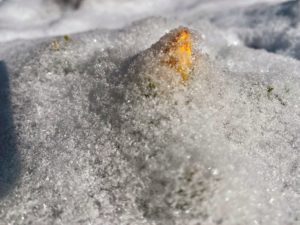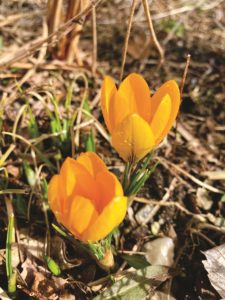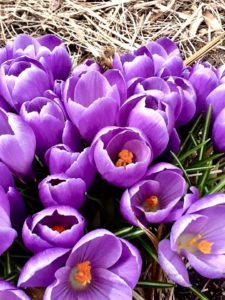In the early days of February, little shoots of yellow-green began emerging from the soil in my gardens, pushing up along pathways and around the roots of trees in the lawn. They were reaching up through the soil in the exact spots I had planted crocus bulbs in the fall. “It’s not time yet,” I said to them as I walked by.


The next day, there were a few more, a slight bit taller. “It’s still winter,” I said. “It’s going to be cold again. Stay under the soil.” I spoke with concern, scooping handfuls of soil into mounds to cover them. In the following days, they grew up through that soil, too.
“You’re braver than I am,” I told the rounded golden tips. They had decided it was time to grow. Something deep in their biology had awakened and begun to move. They would not question it. Now was their moment.

Early on a bright morning, when it was still very cold, a little spot of golden sunshine looked up at me. The crocuses had opened. Two whorls of tissue paper had expanded and unfurled at the edge of the walkway, each with six petals and sepals in layered arrangement, new to this world. The sun filled their upturned cups with a warm, honey-colored light. The petals, softer than a newborn’s skin held by stout stalks, seemed impossibly confident in the winter air. I knelt to see them, the cold soil on my knees.
Crocuses were the first flower I was able to recognize and name. They are to this day one of my favorites. For their beauty, but mostly for their courage. They always arrive earlier than I believe they should. Always at an uncomfortable and uncertain time, when all else is hidden in buds or beneath the ground. Spring will come, they tell me. Flower, and spring will come.

Often, it seems, they rise after a snowfall. I know this, but even so it is a perennial surprise to see a mound of snow settled and melting and tinged with purple. This is the moment of the crocus, when water is set free by the sun’s energy to run down the silk petals that moments before were tightly wrapped in spun buds. They drink the steady drip of meltwater. “Believe,” they say. And we have to.
Daffodils will send up shoots now, but they won’t yet dare to flower. Only the snowdrop blooms before the crocus. Thirty-five to 60 degrees is its range. Above or below this, they are dormant. A crocus begins life as a germinated seed. In late winter, a single shoot grows up and feeds a developing corm. Different from a bulb, which is a nascent bundle of leaves, a corm is a swollen stem base, an organ for storing energy.

As spring nears, a second corm begins to grow on top of the original one. This first mother corm gives birth to a tiny being, this new one called a daughter. That daughter will become a mother the next year and birth its own daughter. A field of crocuses standing purple, white, orange, and yellow against the snow is a family of mothers and daughters.
On that bright morning, as I knelt down to see up close the golden whorl at the edge of my walkway, the wind blew. The flower stalks vibrated. “Hello, brave little souls,” I said. All around were little raised mounds of snow, gold light emanating from within.



